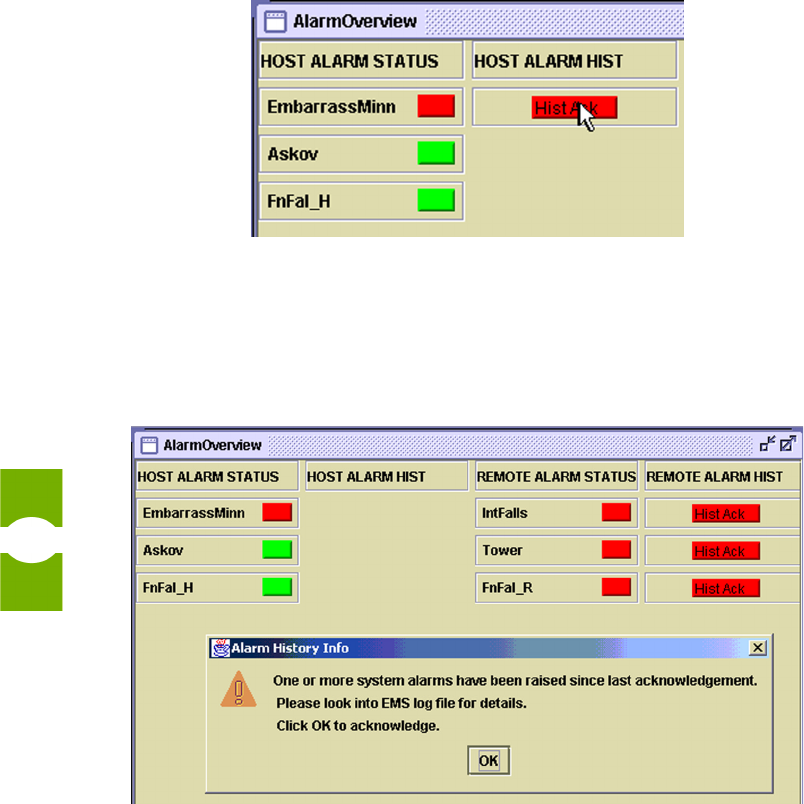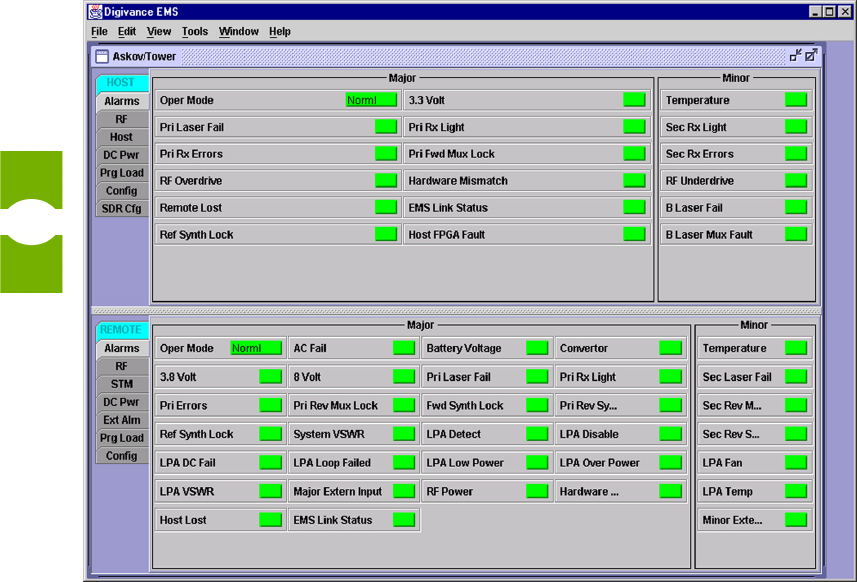ADC Telecommunications DSR0805A Digivance WBDR Base Station User Manual EMSUser
ADC Telecommunications Inc Digivance WBDR Base Station EMSUser
Contents
wbdr part 4

Task-Based Reference Using Alarm Overview to View and
Element Management System (EMS) 4.0 User Manual
39
•ALARM HISTORY Indicator—present only until it is clicked
away, indicates, in effect, whether someone has noticed the alarm and
looked into its significance. The color of this indicator will be that of
the worst alarm existing for the identified network element (if any
major alarm exists, the color will be red).
NOTE: These two types of indicators operate independently from one another. If
the condition causing the alarm is cleared, resulting in a “green” status indicator,
the history indicator will still remain until it is clicked away. By the same token,
acknowledging the alarm has no effect on the alarm status indicator since that has
no effect on the underlying physical condition causing the alarm.
To view and acknowledge alarms
1. Select ViewÞAlarmOverview to display the AlarmOverview window.
2. Look for ALARM STATUS indicators with colors yellow or red, as shown in
Figure 27.
Figure 27. Units With Alarms
3. Interpret the ALARM STATUS indicators as follows:
•Red = one or more major alarms exist. A major alarm places the
identified unit in standby operating mode (stopping RF functions).
•Ye l lo w = one or more minor alarms exist at the network element. A minor
alarm allows the unit to continue functioning in normal mode.
•Green = no alarms exist at the network element.
4. Check if any unit has an ALARM HIST indicator, such as shown in
Figure 28. If any does, click on the ALARM HIST button (labeled Hist Ack)
to start the process to acknowledge the alarm.

Using Alarm Overview to View and Acknowledge Alarms Section 3
Element Management System (EMS) 4.0 User Manual
40
Figure 28. ALARM HIST Indicator
5. When the dialog window shown below in Figure 29 appears, click on the OK
button to indicate that you are aware of the alarm and aware that alarm history
text is available for viewing.
Figure 29. Alarm Overview Example
NOTE: After you click on the OK button, the ALARM HIST indicator will dis-
appear from the display, as shown in Figure 30.
6. Check the EMS log file, as shown in Figure 31, for alarm history text to deter-
mine the events associated with the alarm. For information on how to view the
file, refer to Topic 3.15, Viewing the EMS Log File, on page 53.

Task-Based Reference Using Alarm Overview to View and
Element Management System (EMS) 4.0 User Manual
41
Figure 30. HOST ALARM HIST Cleared
Figure 31. Example of Alarm History Text
7. If desired, also check the alarm detail windows for the host and remote unit.
To interpret the host display, see Topic 4.4.2 on page 71. To interpret the
remote display, see Topic 4.5.2 on page 82.
To view alarm history using the NOC-NEM interface
Use the GET ALARM command (see Topic 5.5.6 on page 101).

Viewing Alarm Detail Section 3
Element Management System (EMS) 4.0 User Manual
42
3.9 Viewing Alarm Detail
Alarm Detail lists and tells the status for all alarm indicators received from the
host/remote pair. There are separate windows for the host and remote units.
To view alarm detail for a host/remote pair
1. From the View menu, select the names of the host/remote pair.
2. The Alarms windows display as shown in Figure 32.
3. To interpret the host display, see Topic 4.4.1 on page 69. To interpret the
remote display, see Topic 4.5.1 on page 80.
Figure 32. Alarm Detail Example
To view alarm detail using the NOC-NEM interface
Use the GET ALARM command (see Topic 5.5.6 on page 101).